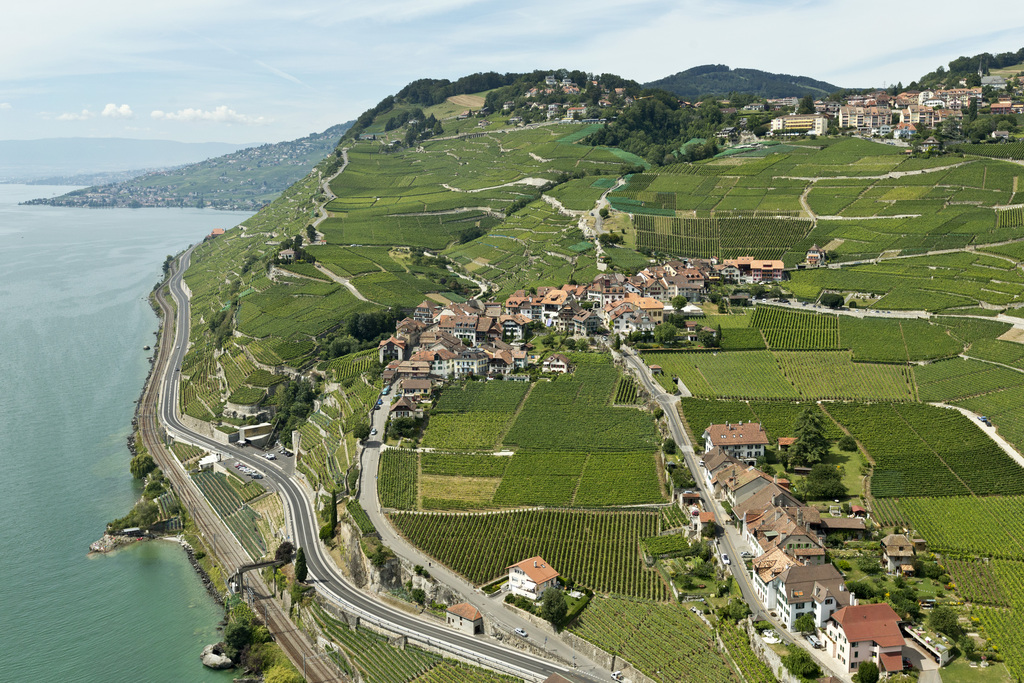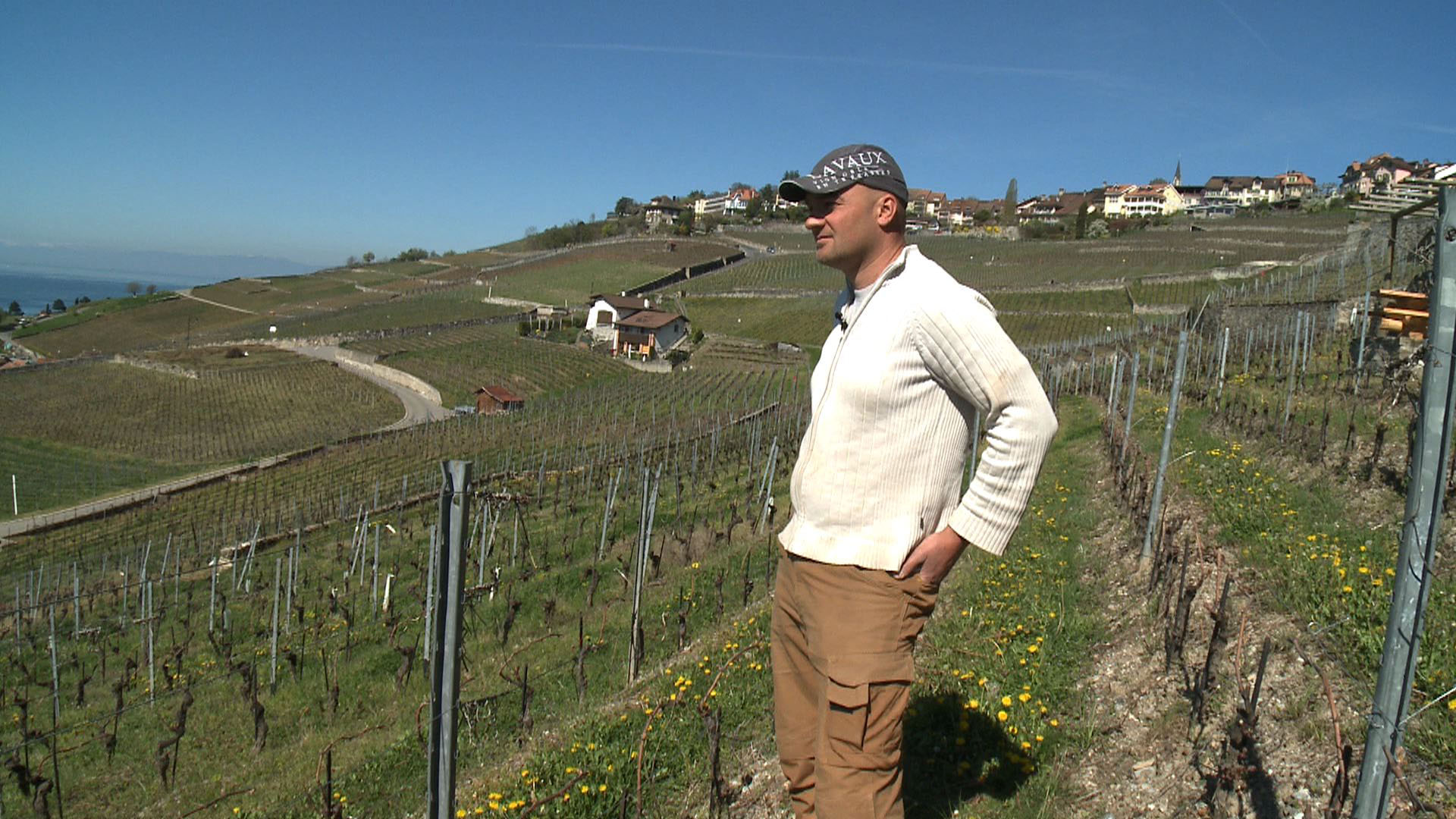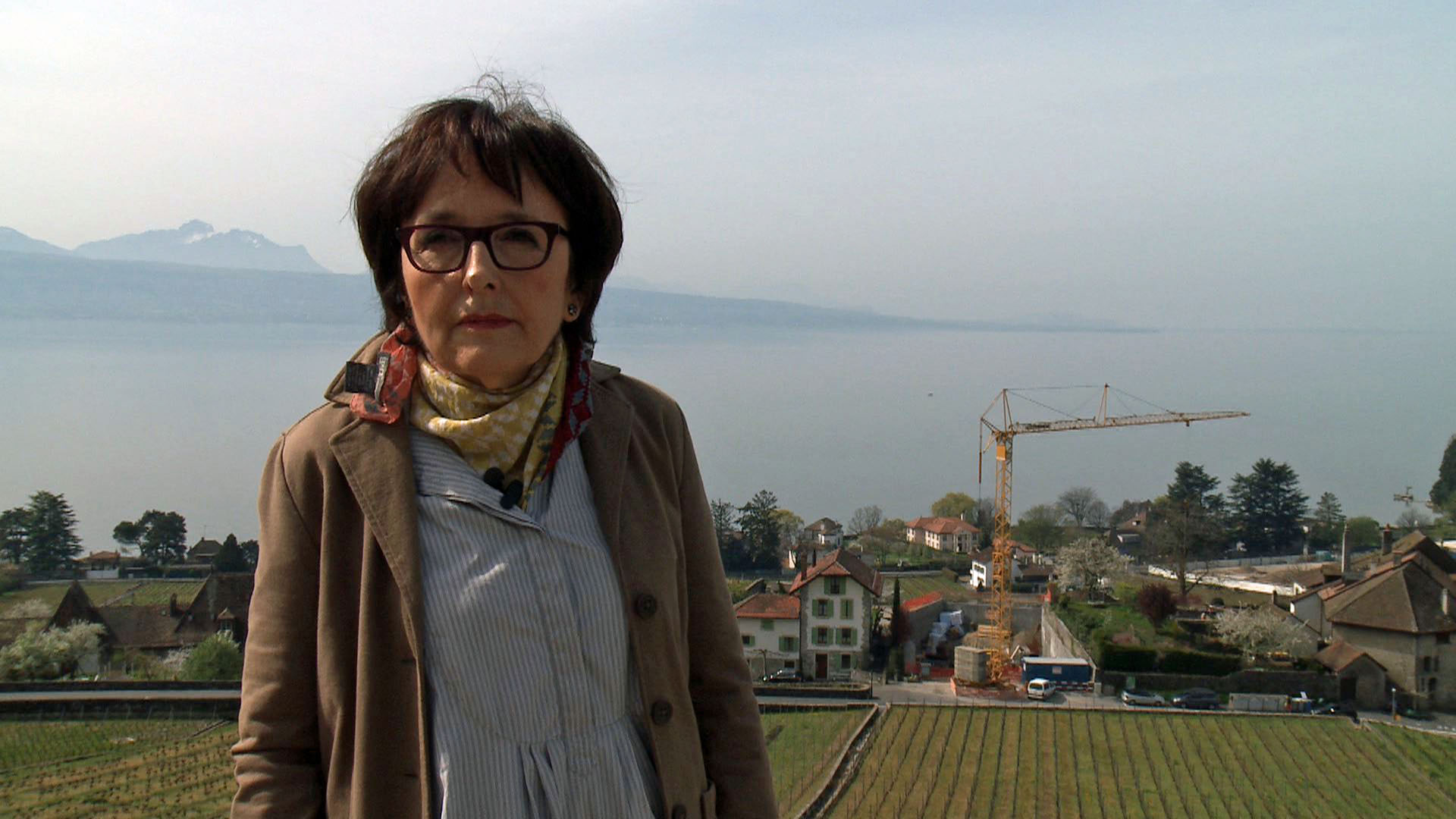
Battle for future of UNESCO wine region

The spectacular Lavaux region is famous for its terraced vineyards, chasselas grapes and UNESCO World Heritage status. But its calm splendour belies a major tussle over the region’s protection status and economic future to be decided in May.
All is quiet on the steep, narrow stone-walled vineyards at Chexbres overlooking Lake Geneva. That is except for the occasional chirping of birds and the scraping noises made by workers clearing weeds from one of the 10,000 terraces.
Constant Jomini makes his way along the lines of vines on his four-hectare property, inspecting the first leaves that have burst through in the early spring sunshine.
The 36-year-old local winemaker has reason to be cheerful. Business is up. His bottles of chasselas and pinot noir have gained much attention recently, even among Swiss-German buyers, and are selling well. So much so that he has invested heavily in a new cellar to meet future demand.
Yet he remains worried about the future.
“Save Lavaux. Everyone wants to save Lavaux, especially the winegrowers. But that means that winegrowing has to endure and for that we need to develop. I’m not talking about constructing a building in the middle of the vines, but in the villages we need to be able to develop our houses, create cellars and build holiday apartments,” he declared.

More
Winemaker says initiative stops progress
His concerns for the ancient wine region, whose origins can be traced back to the 11th century, stem from the so-called “Sauvez Lavaux III” initiative to be decided on May 18.
That day voters from canton Vaud will get to choose between two proposals, one initiated in 2009 by activist Franz Weber, who was instrumental in the two earlier initiatives to protect Lavaux, and supported by environmental groups like WWF and Pro Natura. It calls for stricter planning regulations to deal with unrestrained property speculation which they say is slowly eating away at the region.
Supporters of a counterproposal – most political parties and Lavaux winegrowers – retort that the region is already well protected by existing cantonal and federal laws, so much so that UNESCO granted it World Heritage status as a ‘cultural landscape’ in 2007. They claim their proposal, with its cross-party support, would ensure the region’s socio-economic development and protection, rather than radical measures to conserve it ‘like a forest or national park’.
Their plan would reduce the scale of the zones people can build on while authorising public buildings and housing. They also promise financial support to winegrowers to help maintain their terraces.
Arguments between the two sides have been flying in all directions in recent weeks accompanied by posters and film campaigns.
Lavaux is a district in canton Vaud located on the northeastern shore of Lake Geneva. The prestigious wine-growing region stretches for about 15km from Vevey to the eastern outskirts of Lausanne, comprising 840 hectares of terraced vineyards covering the lower slopes of the mountainside between the villages and the lake. There are 28,000 residents.
Although there is some evidence that vines were grown in the area in Roman times, the present vine terraces can be traced back to the 11th century, when Benedictine and Cistercian monasteries controlled the area.
The wines produced are mainly Chasselas (68.5%), Gamay (10.9%) and Pinot Noir (11.5%). They are regrouped into eight Appellations d’origine contrôlées (AOC) or protected designation of origin wines: Calamin, Chardonne, Dézaley, Epesses, Lutry, St-Saphorin, Vevey-Montreux and Villette. There are currently around 200 winegrowers in Lavaux.
Chipping away
Constant Jomini’s family business may be thriving, but not all are as lucky. Some Swiss winemakers have struggled after a recent drop in prices, fewer wine drinkers and foreign competition. They worry the initiative may be the final nail in the coffin.
“The first danger for Lavaux is the death of the winemaking business, not property speculation,” centre-left Social Democrat Jean-Christophe Schwab, a supporter of the counter-proposal, told a packed meeting of 300 concerned winegrowers and locals in March in Chexbres.
But Suzanne Debluë doesn’t see it that way. For 40 years the Lutry resident has been following in her father’s footsteps challenging contentious local building projects to ensure this ‘heritage doesn’t deteriorate’.
“This countryside belongs to all of us, not just the property owners who think they can do with it what they want,” she says, pointing at individual villas dotting the hillside above Lutry.
The secretary of the Sauver Lavaux association believes property developers are slowly chipping away at the site and winegrowers are either ignoring the reality or are working hand in glove with the local decision-makers. Some locals mayors have done a good job in protecting their communes but not enough, she bemoans.
“The two previous Lavaux initiatives have managed to protect a large part of the central protected wine-growing zone. But the upper parts – the so-called crown – and the lake shore have been badly handled over the past 30 years,” she said.
The people behind the initiative say this problem has got worse in recent years owing to demographic pressure from Lausanne and Vevey. Armed with photographic evidence Debluë says big property developers are transforming old winegrowing properties and building million-franc luxury apartments and villas out of reach of most locals.

More
Fighting for more building restrictions
“Since July 2011, 450 building projects have been opened for public scrutiny in the Lavaux communes but only a dozen concern wine-related infrastructure,” said lawyer Laurent Fischer, for the initiative.
These figures are contested by opponents like Chardonne winemaker Maurice Neyroud, who called them ‘invented’ and ‘scandalous’.
But there are a few lone voices of protest among local winegrowers, like that of 90-year-old Marco Leyvraz, who denounces the ‘new invasion of property and cash’. “It disgusts me,” he told reporters at the initiative press conference.
Supporters of Weber’s proposal want to therefore extend the existing protected area both north- and southwards to take account of growing urbanisation and to take the urban planning for Lavaux out of the hands of the local communes.
UNESCO granted the Lavaux region World Heritage status as a ‘cultural landscape’ in 2007.
The status, however, does not impose any legally binding protection obligations on the Lavaux winegrowers or the local or federal authorities. But to keep what is seen by some as a marketing label, the Swiss have to follow an approved management plan to maintain the site’s ‘outstanding universal value’.
This outlines strategies for research and culture, economy, land-use planning and tourism and is overseen by a Swiss association comprised of local politicians, winemakers and other business figures.
According to winegrower Bernard Bovy, the UNESCO status ‘protects the stones but also the people and their work’. But the initiative supporters argue that the status has changed nothing, ‘on the contrary it has increased the attractiveness of the region for people wanting to live there’. So far UNESCO has stayed out of the initiative debate.
“Ever since it was inscribed UNESCO has never commented on the state of conservation of Lavaux,” said Oliver Martin, head of the cultural heritage section at the Federal Culture Office.
Limited constructions
Under their proposal new constructions would be strictly limited, but exceptions would be made to allow winemakers to continue to transform and renovate their infrastructure according to their needs while respecting the traditional character of the villages. Work on public buildings like hospitals, schools and retirement homes would also be exempt.
Constant Jomini doesn’t believe a word of it.
“Exceptions! What are they going to do? Give them to some and not to others?”
He looks out towards the Alps in the distance.
“This is one initiative too many. If Lavaux becomes a museum there will be no development and if there is no development, it’s the slow death of winegrowing and UNESCO will no longer accept Lavaux as a protected wine region….that’s the big risk.”

In compliance with the JTI standards
More: SWI swissinfo.ch certified by the Journalism Trust Initiative




























You can find an overview of ongoing debates with our journalists here . Please join us!
If you want to start a conversation about a topic raised in this article or want to report factual errors, email us at english@swissinfo.ch.